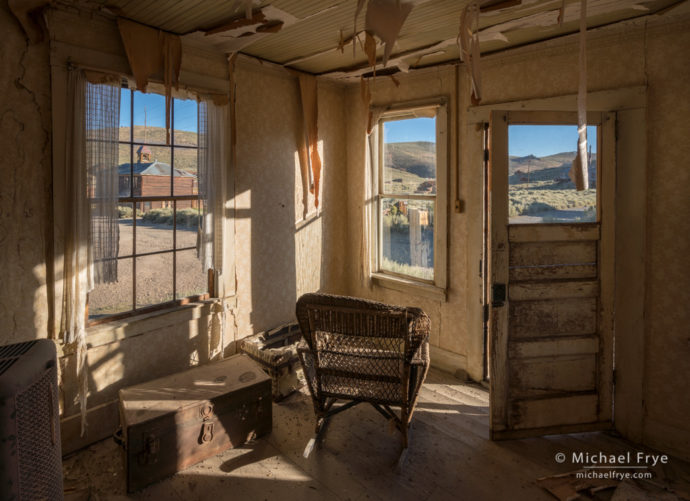
McMillan House interior, Bodie State Historic Park, California. The high contrast of this scene required using Lightroom’s HDR Merge. Also, I deliberately avoided having sunlit areas touch the borders of the image. A bright spot along the edge would pull the viewer’s eye out of the photograph.
As I’ve explored this place, I’ve realized that I’m not as interested in the abandoned mining equipment and machinery, as fascinating as some of those things are. I’m drawn more to the places where people once ate and slept and drank and socialized, and left behind the artifacts of their lives – furniture, cooking utensils, books, magazines, pictures, cans, bottles, a baby carriage, a bird cage, sewing machines, coats, pants, hats, shoes…
To me, there’s something poignant about those things. They’re the only tangible evidence left of people who lived full, rich lives, but have been long forgotten. In Bodie you can sense their presence, and begin to imagine what their lives might have been like.
Photographing those interiors is challenging. Clutter and chaos abound, so a big part of the challenge is trying to simplify your compositions. But just like landscapes, or any other photograph, it helps to have a clear focal point, and to look for repeating patterns — as I tried to do in the following two images.
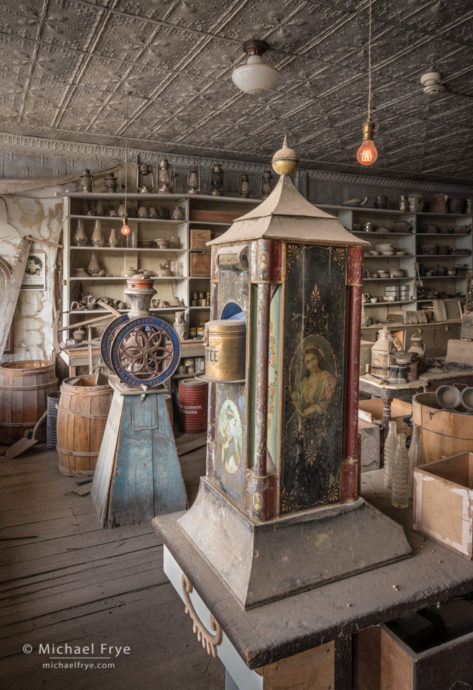
Boone General Store, Bodie State Historic Park, California. The coffee bin on the right is the main focal point. The coffee grinder on the left provides a repeating echo, plus there are other repeating patterns in the shelves and ceiling. Soft window light from the left created perfect illumination for a scene like this.
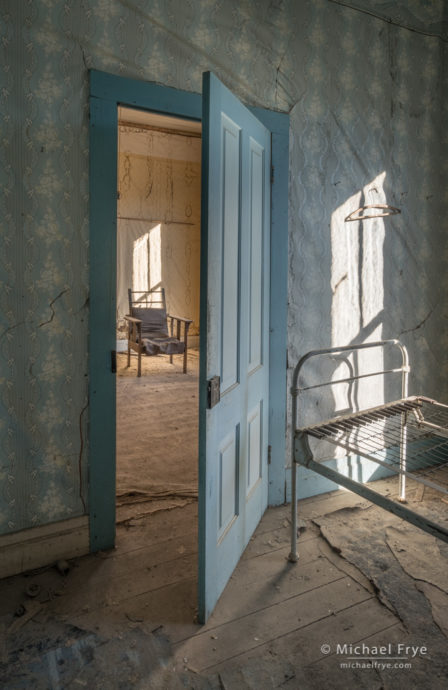
Miller Boarding House, Bodie State Historic Park, California. More repetition, this time from patches of sunlight coming through two similarly-shaped windows, and the door, which is almost a mirror image of the spots from the windows. There are also many vertical and diagonal lines, setting up other subtle patterns.
And of course lighting is vital. Soft window light is wonderful, when you can find it. This is the light that painters have been using for portraits and interior views for centuries, and for good reason. It has direction, which brings out form and texture, but avoids the harshness of sunlight and shade:
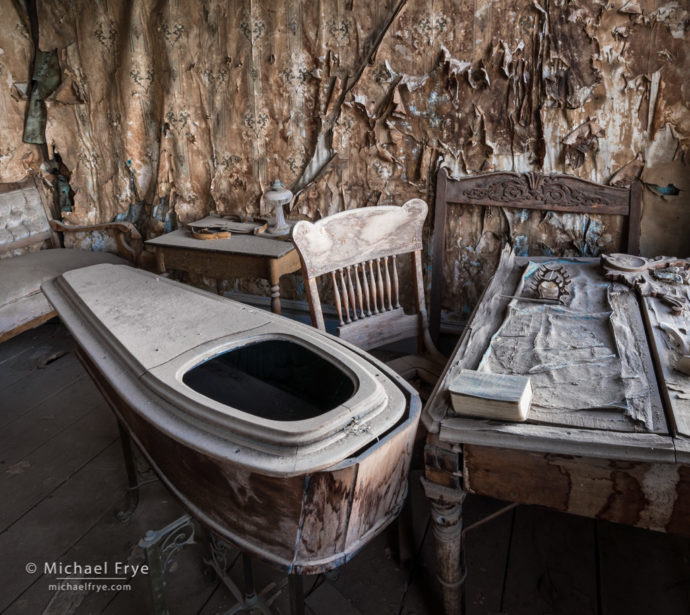
Interior of the morgue, Bodie State Historic Park, California. Window light coming from the right helped accentuate the amazing textures in this room.
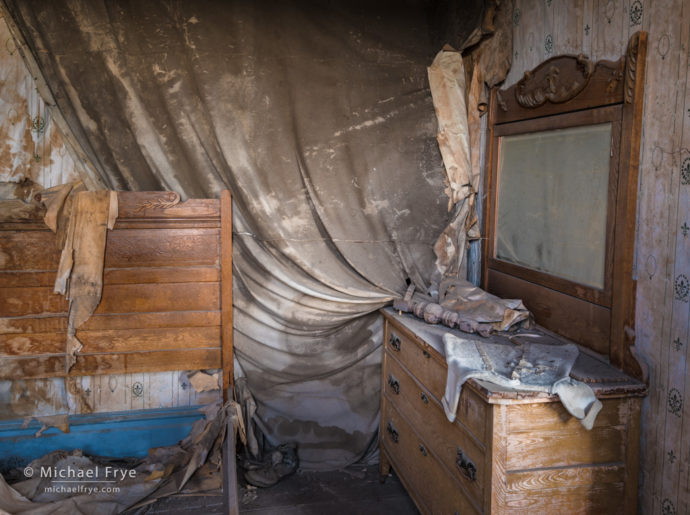
Bedroom in the morgue, Bodie State Historic Park, California. More window light, but this time coming mainly from behind the camera. This soft frontlight didn’t emphasize textures as much, but did help to bring out the beautiful subtle colors in this room.
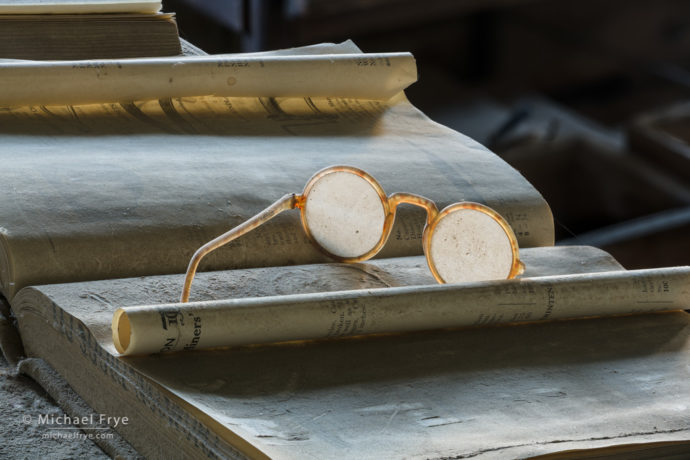
Eyeglasses, Boone General Store, Bodie State Historic Park, California. Here window light was coming from behind the subject, creating a soft, backlit translucence along the rims of the glasses and through the curled pages. There’s a clear and obvious focal point.
But sunlight can work too. In the morning the sun streams in through the many unshaded, east-facing windows in Bodie, throwing random spotlights into the rooms. These scenes can have extreme contrast, so bracketing and blending exposures is often required. But the main ingredient is that the sun has to hit something interesting, something you can build a composition around. If your main subject is lit by the sun, surrounded by darker areas, then the viewer’s eye will be drawn to that subject. If your main subject or focal point is in the shade, with sunlit areas next to it or behind it, that’s a problem, because you’ve created a visual tug of war between what you want people to look at – your subject – and what their eye is naturally drawn to – the brightest parts of the photograph. In these images I tried to use sunlight to draw the viewer’s eye to key parts of the scene:
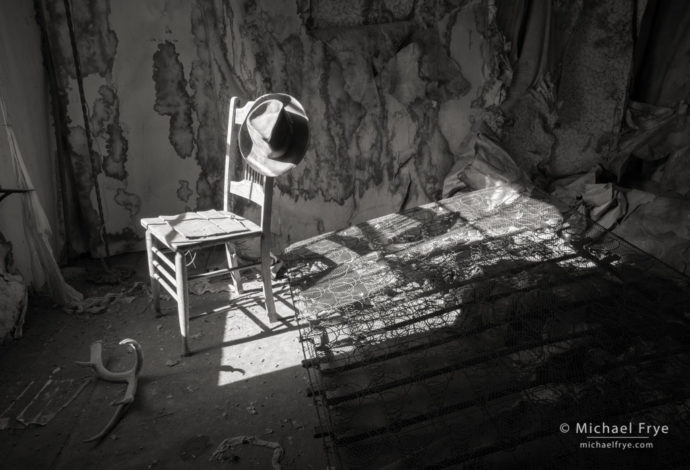
Chair and hat, Reddy House, Bodie State Historic Park, California. Sunlight draws the eye to the main focal point, the hat on the chair. This is an HDR merge.
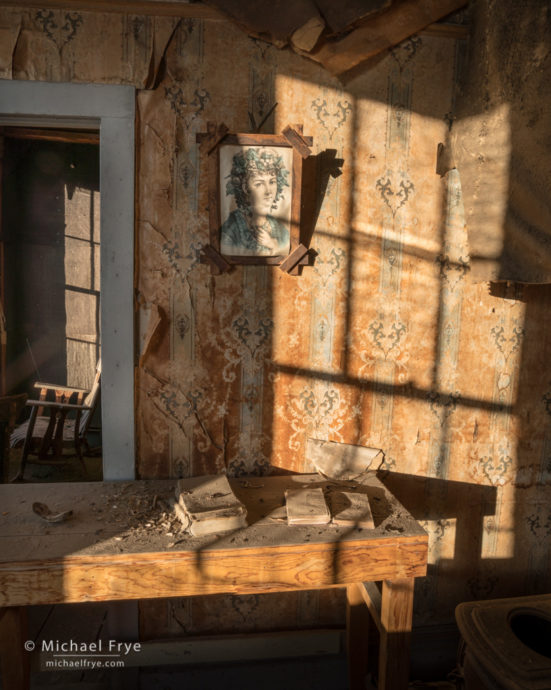
Books, portrait, and chair in the morgue, Bodie State Historic Park, California. Here the sun highlights three focal points: the picture, the books on the table, and the chair in the adjacent room. I made sure no bright spots touched the edges of the frame, as that would pull the eye out of the photograph. Just one image – no HDR merge necessary.
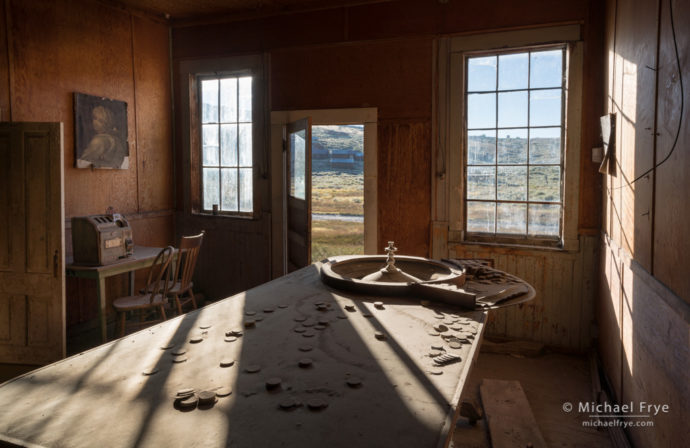
Morning light in the Sam Leon Bar, Bodie State Historic Park, California. The sun highlights the main focal point, the roulette wheel, and creates some diagonal shadows on the table. Here I couldn’t avoid having one bright area touch the lower-left part of the frame, but darkened that region a bit with the Adjustment Brush in Lightroom. Again this is just one image, using Lightroom’s Highlight and Shadows tools to balance the contrast.
But aside from these technical and esthetic considerations, photographing Bodie is another confirmation, for me, that it’s much easier to photograph subjects you care about. If you feel a connection with the place you’re photographing, if you’re inspired or even moved by the subject, that somehow comes through in the photographs. And finding those connections is ultimately far more important than f-stops and shutter speeds. I’m glad I found a connection with Bodie, even though it’s not my typical subject matter.
— Michael Frye
Related Posts: Bodie at Night; Inside Bodie
Michael Frye is a professional photographer specializing in landscapes and nature. He is the author or principal photographer of The Photographer’s Guide to Yosemite, Yosemite Meditations, Yosemite Meditations for Women, Yosemite Meditations for Adventurers, and Digital Landscape Photography: In the Footsteps of Ansel Adams and the Great Masters. He has also written three eBooks: Light & Land: Landscapes in the Digital Darkroom, Exposure for Outdoor Photography, and Landscapes in Lightroom: The Essential Step-by-Step Guide. Michael has written numerous magazine articles on the art and technique of photography, and his images have been published in over thirty countries around the world. Michael has lived either in or near Yosemite National Park since 1983, currently residing just outside the park in Mariposa, California.









Thank You for these and the pointers in your write up. I will post it on the Ladysmith Camera Club website for our members.
You’re welcome Patricia, and thanks!
Was last in Bodie 35+ years ago. Remember how amazing place is. Pl let me know if you do another group session there. Even though I’m an east coast guy, I’d make the trip.
Dennis, we will probably do another interior sessions next year, but not certain about that yet. They don’t issue the permits until February, so look for an announcement then.
I would love to try and photograph these interiors. Your shots are just amazing!
Thanks Laura!
You are not the only one more interested in the lives of people rather then old equipment…. I find it beyond aggrevating that pro photographers sometimes can look behind and over otherwise closed doors and others can not. Even more aggrevating is that you can take students there again whilst other people can not take a few photo’s… Measuring with two different measering scales… What is the use of preserving a historic place if it can not be seen by those who it is supposed to be preserved for…
Catherine, you’re making an assumption that only pro photographers can get permits to go inside the buildings at Bodie, but that’s not the case. Anyone can get a permit if they’re willing to pay the fees and provide liability insurance. Many clubs, small groups, and even individual photographers do this. The fees go to Bodie’s stabilization projects. You can find out more here:
http://www.bodiefoundation.org/photo-workshops/
> What is the use of preserving a historic place if it can not be seen by those who it is supposed to be preserved for…
I don’t know if you’ve been to Bodie, but if you go it’s easy to see that if everyone were let into the buildings there wouldn’t be anything worth preserving after about a month, if that long. Those interiors are very fragile.
Thank you for the unique perspective of Bodie through your art. The images shown really accentuates the contrast between what once was (the life in Bodie ) and what now remains.
I was with Forestry in the 1970’s and visited Bodie quite often. Restrictions had to be placed on allowing entry to certain building due to the thievery of artifacts and furniture. The piano was stolen from the church, among other things, etc. Scavengers were desperate and making the trip into Bodie when it was closed for the winter season and taking things of value from the buildings.
This was quite common with other “ghost towns” too but Bodie was an easy target due the the fact it was so isolated and off the beaten path. Great shots!!
Thanks for chiming in here Richard. I know theft was a big problem for awhile; that’s one of the reasons they have rangers living on site year-yound now.
Great shots. I was just there a few months ago, but of course did not have the access you have. I love your shots of the personal belonging of the people.
I love your caption on the first photo about “deliberately avoided having sunlit areas touch the borders of the image.” and the reason for it. Great tip.
This is one of the most informative posts I have read in a long time.
I have a stupid question. Is there concern when you have access of disturbing the nice even layer of dust on the floors? I assume you cannot touch any of the artifacts, so that dust is safe. I have not seen footprints inside the buildings, but maybe I have not looked carefully enough at the floors.
Thanks Aram! The floors are the only thing you’re allowed to touch when you’re inside the buildings. Even brushing up against a table with your jacket and disturbing the dust is a no-no, possibly subjecting you to ejection from the park. Some of the floors are pretty rickety, so the monitors tell you which areas you have to avoid stepping on.
Thanks, Michael, for the lovely images and commentary about the photographs and their composition. My experience is that photographing interiors, particularly those with sunlight, can very difficult. I really appreciate your advice and suggestions, particularly the idea of using HDR merging to control contrast.
I was fortunate to have had the opportunity, many years ago, to participate in a project to find and gather up all the historical documents in the buildings in Bodie for the California State Park Archives. Our team has total access to all the structures and it was amazing to see them at that time (1987) in their “state of arrested decay.” It is really an amazing slice of history.
Your comment above to Catherine is certainly true, the structures at Bodie, both inside and out, are an extremely fragile environment. It is images like yours that help us to have a vision of Bodie’s past and image what life was 150 years ago until its demise in the 1930s. Many thanks for the post!
You’re welcome Bob, and thanks for sharing your story about gathering up the historical documents from Bodie. I wonder if the current rangers know about those archives – I hope so.
Great shots, coupled with good descriptions of what you did to make them work. I’ve been to Bode a couple of times and find it fascinating, but getting photos to convey a sense of the place is not easy. So that gives me extra appreciation for what you’ve done here.
Thanks very much Jeff. Bodie can certainly be challenging to photograph!
Love thes they are awesome. Never saw a metal casket-coffin so was thrilled. Obsessed with churches, church cemetaries, all cemetaries, weird wild to me. Amateur photographer just for my own collection Time stands still is wonderful to me. Would love to tag along if possibly. Retired. Live in Cali. You can stay with my husband and I if you would like.
Thank you Janet! We may do another Bodie workshop next year; if so we’ll announce it around February.
Oh, I’m excited. And ready. Thanks keep in touch and let me know!!!!!
if you do, my wife and I will be there! Sign me up now! 🙂
I wish I Was able to get a permit when I visited last summer. I emailed the foundation explaining that was coming in from the east coast, and offered to pay several hundred dollars for limited access. I got a response that the only way to get inside was to join a workshop,which was not happening when I was there. So, that left me shooting through the dirty windows, not bad, but as good as getting inside…..
I’m surprised by your story Bob, because I know that they do give permits to private individuals. Perhaps their schedule was already full; I think they may limit the number of days.
Yeah, must have caught them at a bad time…..maybe next time, I will be going back in the future. I will be in Montana in two weeks shooting Bannack and Garnet. Bodie got me hooked on “ghost towns”…..
I love shoots like this, that are a little different than the usual. I, personally, have a very hard time shooting this type of environment, though I really enjoy seeing photos others have created. Yours are fantastic. I love the image of the general store with the coffee tin, and the image of the hat on the chair. Both are great storytelling images, though I think in vastly different ways. The hat on the chair has a real emotional pull to it. I need to study more of these sorts of images, learn what it is I like about them, and then practice creating my own. Thanks for the post!
Thanks Todd. Photographing interiors like this can indeed be challenging!
I’ve seen many photos of the exteriors and abandoned equipment around Bodie, but I find your photos of the interiors so interesting. They leave me with questions on why so many things got left behind (although I suspect it was just the simple issue of not having the means to move everything when residents left). Thank you for sharing your experience, Michael!
I suspect you’re right Vivienne – people just didn’t have a way of taking everything with them. Or they intended to come back and get their stuff, but never did. Sometimes after you live without something for awhile you realize that you don’t need it. 🙂
Are you going to publish these in a book? I’d LOVE it if you did!
Well I hadn’t thought about that Bill, but maybe!
Michael- A book like that would be a HUGE addition to a visit to Bodie since most folks can’t go inside and get these kinds of views. The park service would probably love to sell it too!
*Very* interesting blog post – really enjoyed it. Enjoyed your composition in the photographs, too. I’ll share this one.
Thanks Jon!
When you make a trip count me in. Amateur photo taker.
Janet, if you’d like to learn about future workshops please make sure you’re signed up for my mailing list.